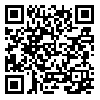Volume 17, Issue 4 (Vol.17, No.4, Winter 2022 2022)
irje 2022, 17(4): 302-310 |
Back to browse issues page
Download citation:
BibTeX | RIS | EndNote | Medlars | ProCite | Reference Manager | RefWorks
Send citation to:



BibTeX | RIS | EndNote | Medlars | ProCite | Reference Manager | RefWorks
Send citation to:
Arian-Mehr T, Karami M. Performance Evaluation of Moving Epidemic Method Model in Determining Threshold Levels of Influenza Outbreaks in Iran. irje 2022; 17 (4) :302-310
URL: http://irje.tums.ac.ir/article-1-7130-en.html
URL: http://irje.tums.ac.ir/article-1-7130-en.html
1- Students Research Committee, Hamadan University of Medical Sciences, Hamadan, Iran
2- Professor of Epidemiology, Department of Epidemiology, School of Public Health and Safety, Shahid Beheshti University of Medical Sciences, Tehran, Iran;Professor ,man.karami@yahoo.com
2- Professor of Epidemiology, Department of Epidemiology, School of Public Health and Safety, Shahid Beheshti University of Medical Sciences, Tehran, Iran;Professor ,
Abstract: (1931 Views)
Background and Objectives: Timely dection of influenza outbreaks is very important for a better reponse to outbreaks. The aim of this study was to assess the moving epidemic method for determinating influenza outbreak threshold levels in Iran.
Methods: The moving epidemic method was applied to the WHO Flunet website data from January 2010 to December 2017 with the aim of determining outbreak alert thresholds. Therefore, the performance of the moving epidemic method in identifying the onset of the outbreak over eight periods was reported using sensitivity and specificity indices.
Results: A total of 69169 influenza-like illnesses were recorded in the Fluent website during the study period. The smallest number of influenza-like illnesses for the epidemic was 187 cases in the third period (2011-2012) and the maximum number was 1086 cases in the seventh period (2016-2015). The earliest epidemic occurred during the third and eighth periods of the 48th week, approximately in mid-February. The minimum duration of the epidemic was 8 weeks and the maximum was 13 weeks. The overall sensitivity and specificity of the moving epidemic method were 55% and 96%, respectively.
Conclusion: The moving epidemic method could be used as a complementary method to detection of influenza outbreks. It is recommended to apply the moving epidemic method on influenza and similar communicable diseses.
Type of Study: Research |
Subject:
Epidemiology
Received: 2022/07/31 | Accepted: 2021/03/21 | Published: 2021/03/21
Received: 2022/07/31 | Accepted: 2021/03/21 | Published: 2021/03/21
Send email to the article author
| Rights and permissions | |
 |
This work is licensed under a Creative Commons Attribution-NonCommercial 4.0 International License. |





